|
Day 1
The group arrived in Jackson late in the evening after a long journey from the UK. They were met by Gina and Steve at the airport. Despite their weariness, some managed to appreciate the clear starlit skies and the bright glow of moonlight on the jagged peaks of the Grand Tetons. Before long, we were settled into our comfortable accommodations in downtown Jackson.
Day 2
The morning off was much appreciated and allowed everyone to recover from the long journey. By mid-day we were ready to explore the grand landscape surrounding Jackson. After lunch at a local steakhouse, Gina took the group to the Jackson Visitor Center overlooking the National Elk Refuge while Steve went to the airport to pick up Kate. The sky was bright and blue illuminating the expanse of the flat valley of Jackson Hole that sprawled out from the Visitor Center. Birding began immediately as several Yellow-headed Blackbirds flew across the road from the parking lot to some buildings. The pond next to the car park contained Northern Shoveler, Gadwall, and a family of Mallards with young scattered all across the water. Violet-green Swallows flew low overhead and perched on the eaves of the building giving good views. At the edge of the pond, a female Cassin’s Finch foraged on the mud. Red-winged Blackbirds flew back and forth over the pond noisily proclaiming their breeding territory.
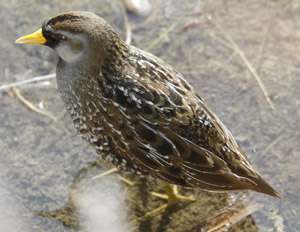 We walked around to the lower observation deck and noted several Canada Geese with goslings on the lawn. In the ponds were Cinnamon Teal, Green-winged Teal, American Coot, and several Yellow-headed Blackbirds. A Yellow Warbler sang from a low willow white American Magpies and Common Grackles flew among the fence posts and reeds. Two Trumpeter Swans flew to a far pool. We hoped they would come closer but they kept their distance. A Killdeer landed on a small mudflat at the far end of the pool and while we were scoping it we noticed a Great Blue Heron foraging along the edge. Spotted Sandpipers also worked the edge and a few Barn Swallows flew with the Violet-greens. Gina spotted a Bullock’s Oriole on top of a spruce near the Visitor Center and it sat for all to view. We turned around to look at the marsh just as two close Soras crossed the open water and disappeared in the reeds. We walked around to the lower observation deck and noted several Canada Geese with goslings on the lawn. In the ponds were Cinnamon Teal, Green-winged Teal, American Coot, and several Yellow-headed Blackbirds. A Yellow Warbler sang from a low willow white American Magpies and Common Grackles flew among the fence posts and reeds. Two Trumpeter Swans flew to a far pool. We hoped they would come closer but they kept their distance. A Killdeer landed on a small mudflat at the far end of the pool and while we were scoping it we noticed a Great Blue Heron foraging along the edge. Spotted Sandpipers also worked the edge and a few Barn Swallows flew with the Violet-greens. Gina spotted a Bullock’s Oriole on top of a spruce near the Visitor Center and it sat for all to view. We turned around to look at the marsh just as two close Soras crossed the open water and disappeared in the reeds.
We checked the upper observation deck and the ranger told us about a Bald Eagle nest in the trees on a distant hillside. We scoped it and soon found the eagle which mostly looked like a brown lump on a branch. Out in the Elk Refuge we could see two Sandhill Cranes walking and foraging. We had a few minutes to explore the inside of the Visitor Center and then drove west of Jackson to Wilson, Wyoming.
On the way to Wilson, we passed an Osprey nest on a power pole next to the road and we could see the head of a bird sitting on the nest. We ascended the mountain toward Teton Pass and checked an area on a steep hillside where we found a Three-toed Woodpecker (first spotted by Kate). In the open areas we saw our first of many ground squirrels, the Wyoming Ground Squirrel chattering and working among its burrows. A Red-tailed Hawk flew over allowing us great flight views.
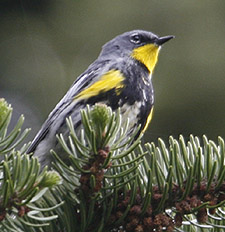 We headed back down the mountain to the Fish Creek area. We stopped near a bridge over Fish Creek where we saw four Turkey Vultures lazily drifting along the ridge above. A nice Black-headed Grosbeak sang for us and showed well, and we were able to see Mountain Chickadee and Audubon’s Warbler in the thick branches of a large spruce by the side of the road. Further up the road, we got great looks at Green-tailed Towhee in low vegetation on a hillside. Yellow Warblers flitted among the shrubs along the stream and a Mourning Dove flew by. Broad-tailed Hummingbirds also buzzed around and one landed on a bare branch just up the hill so we could scope it. Its bright gorget glowed as it turned at the right angle to the light garnering “wows” from the crowd. An Olive-sided Flycatcher was also spotted up the hill and across the river a female Red Crossbill perched high atop a tree. We traveled up the road to turn around and spotted a lone male Barrow’s Goldeneye in the river. We headed back to Jackson with a quick stop at a roadside pond for American Wigeon, American Coots with young, two Trumpeter Swans, and a Ruddy Duck. We arrived back in Jackson just in time for the nightly shootout and then met up for dinner in town at an authentic Mexican restaurant. We headed back down the mountain to the Fish Creek area. We stopped near a bridge over Fish Creek where we saw four Turkey Vultures lazily drifting along the ridge above. A nice Black-headed Grosbeak sang for us and showed well, and we were able to see Mountain Chickadee and Audubon’s Warbler in the thick branches of a large spruce by the side of the road. Further up the road, we got great looks at Green-tailed Towhee in low vegetation on a hillside. Yellow Warblers flitted among the shrubs along the stream and a Mourning Dove flew by. Broad-tailed Hummingbirds also buzzed around and one landed on a bare branch just up the hill so we could scope it. Its bright gorget glowed as it turned at the right angle to the light garnering “wows” from the crowd. An Olive-sided Flycatcher was also spotted up the hill and across the river a female Red Crossbill perched high atop a tree. We traveled up the road to turn around and spotted a lone male Barrow’s Goldeneye in the river. We headed back to Jackson with a quick stop at a roadside pond for American Wigeon, American Coots with young, two Trumpeter Swans, and a Ruddy Duck. We arrived back in Jackson just in time for the nightly shootout and then met up for dinner in town at an authentic Mexican restaurant.
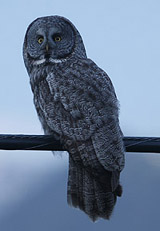 After dinner we headed back to Wilson where Gina and Steve had found a special bird and hoped it would show again for the group. We parked across from a ranch with several horses in the field and by now the word was out that we were after a Great Gray Owl. Within a few minutes, some American Robins gathered in the pines above us and scolded loudly. We looked up and could see that a Great Gray Owl perched there. The owl then flew down and landed on a power line near the road right in front of us allowing extraordinarily close looks. Seemingly unaware or unconcerned by our presence, the bird searched the open area for prey and flew down at one point to catch a vole. We enjoyed the bird at close range for several minutes until it became too dark to see. What a bird! What a show! What a first day! After dinner we headed back to Wilson where Gina and Steve had found a special bird and hoped it would show again for the group. We parked across from a ranch with several horses in the field and by now the word was out that we were after a Great Gray Owl. Within a few minutes, some American Robins gathered in the pines above us and scolded loudly. We looked up and could see that a Great Gray Owl perched there. The owl then flew down and landed on a power line near the road right in front of us allowing extraordinarily close looks. Seemingly unaware or unconcerned by our presence, the bird searched the open area for prey and flew down at one point to catch a vole. We enjoyed the bird at close range for several minutes until it became too dark to see. What a bird! What a show! What a first day!
Day 3
This morning we did an early run to look for Sage Grouse in the sagebrush flats. We were on the road before the sun came up and had a very close encounter with a bison and calf as it crossed in front of us. We spotted the silhouette of a Great Horned Owl in a tree as the sky began to light up. As the owl flew off, we were able to follow it until it landed on a distant tree. In the sagebrush flats, we heard and then saw a Sage Thrasher which gave fairly good looks. A Long-billed Curlew was spotted in an open area and we got our first looks at American Crows, Common Ravens, and Western Meadowlarks. We headed back to Jackson for breakfast and then went back out by the Elk Refuge stopping at a pullout to scope yesterday’s Bald Eagle on its nest. We were pleased with the views of this magnificent bird on the large stick nest overlooking the valley.
From here we went to Grand Teton National Park north of Jackson enjoying awesome views of the rugged peaks of the mountains against the crystal clear blue sky. We climbed Signal Mountain which yielded spectacular views from the top. In the parking lot, we got great looks at a bright Western Tanager, Red-breasted Nuthatch, and a singing Audubon’s Warbler.
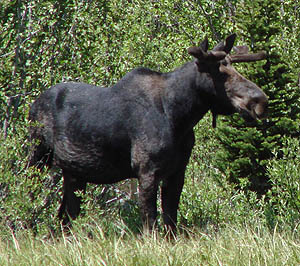 Our next stop was Jackson Lake Dam, where two Peregrine Falcons were spotted flying across the lake and landing on the far end of the dike. We scoped a flock of American White Pelicans and some distant Western Grebes. Steve spotted a Coyote close to the road and a Northern Harrier quartered over the wet meadows in the distance. Our next stop was Jackson Lake Dam, where two Peregrine Falcons were spotted flying across the lake and landing on the far end of the dike. We scoped a flock of American White Pelicans and some distant Western Grebes. Steve spotted a Coyote close to the road and a Northern Harrier quartered over the wet meadows in the distance.
At a pond near the edge of the Snake River, we found a male Bufflehead in interesting plumage and a female, some Gadwall, and Barn, Northern Rough-winged, and Tree Swallows.
We moved on to the Oxbow Bend pullout and scoped the far shore of the river where some large mammals were moving in the vegetation. After a few minutes a large Moose stepped out of the bushes, then another, followed by some American Elk. We watched them forage for several minutes and then turned our gaze to the river where several Canada Geese, Common Merganser, and Ruddy Ducks were seen. A flyover American White Pelican forced our eyes skyward in time to see two Bald Eagles and an Osprey against some puffy clouds that appeared in the endless blue sky.
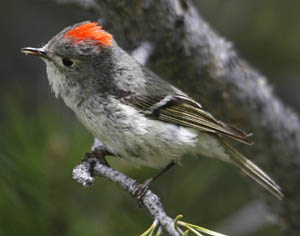 We took a picnic lunch at Colter Bay on upper Jackson Lake with the Teton peaks as a dramatic backdrop. Uinta Ground Squirrels and a Red Squirrel foraged among the pines around the picnic area. While we were eating we could hear the incessant call of a Ruby-crowned Kinglet which finally came down from the tree tops and showed its brilliant scarlet crest. We enjoyed great looks at this little beauty for several minutes as it flashed its seldom-seen crown for us. After lunch, we walked toward the Visitor Center catching Common Grackle and another American White Pelican. Meg pointed out a California Gull and we found the red-shafted form of the Northern Flicker in some tall pines. Leaving Colter Bay, we stopped at a pond with both male and female Barrow’s Goldeneyes and enjoyed great looks at these handsome ducks. We took a picnic lunch at Colter Bay on upper Jackson Lake with the Teton peaks as a dramatic backdrop. Uinta Ground Squirrels and a Red Squirrel foraged among the pines around the picnic area. While we were eating we could hear the incessant call of a Ruby-crowned Kinglet which finally came down from the tree tops and showed its brilliant scarlet crest. We enjoyed great looks at this little beauty for several minutes as it flashed its seldom-seen crown for us. After lunch, we walked toward the Visitor Center catching Common Grackle and another American White Pelican. Meg pointed out a California Gull and we found the red-shafted form of the Northern Flicker in some tall pines. Leaving Colter Bay, we stopped at a pond with both male and female Barrow’s Goldeneyes and enjoyed great looks at these handsome ducks.
At the Willow Flats pullout, a Red-naped Sapsucker gave excellent views but we had to work a bit harder for Lincoln’s and Song Sparrow in the thick brush. A tall pine held a Common Raven nest with young and we watched the adults come in and feed the chicks a few times.
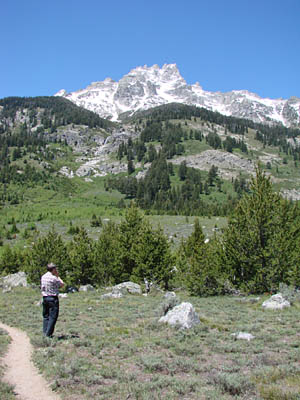 We continued on to Jenny Lake Junction taking the scenic route (wasn't it ALL scenic?). We stopped to look at six elk feeding in sagebrush field and noted one was wearing a radio collar. A roadside stop along the loop produced Gray Jay, close looks at Dark-eyed Junco and Chipping Sparrow, and another Ruby-crowned Kinglet. A Turkey Vulture flew over and we began to wonder whether this bird was really as difficult to see as we were told. We continued on to Jenny Lake Junction taking the scenic route (wasn't it ALL scenic?). We stopped to look at six elk feeding in sagebrush field and noted one was wearing a radio collar. A roadside stop along the loop produced Gray Jay, close looks at Dark-eyed Junco and Chipping Sparrow, and another Ruby-crowned Kinglet. A Turkey Vulture flew over and we began to wonder whether this bird was really as difficult to see as we were told.
We stopped for a snack and coffee at Jenny Lake Visitors Center and enjoyed close looks at Barn Swallows perched on some interpretive signs. Brown-headed Cowbirds worked the ground around the buildings. As we drove out, a flock of thirty or so American Pipits landed in the sagebrush on the side of the road and we were able to get quick glimpses as they disappeared among the vegetation.
On our way past Lupine Meadows, a Coyote was spotted in the open. We drove back out to the highway and toward Jackson. Along the main highway, Liz spotted a Swainson’s Hawk and we got good flight views of it from the road.
We checked a pond at the Elk Refuge from one of the pullouts and added Lesser Scaup, Redhead, Trumpeter Swan, American Wigeon, Cinnamon Teal, and Ring-necked Duck to our list for the day. Though there was still some daylight, some of us were tired from the early start. We enjoyed another lovely meal at the Rendezvous Bistro and couldn't’t help but wonder if our Great Gray Owl was back in its spot. We’d had another fantastic day and reviewed our growing list of species back at the hotel.
Day 4
After breakfast, we checked Miller Butte in the Elk Refuge. The butte rises up from the sagebrush flats and provides rocky habitat for Rock Wren which we got great looks at Violet-green Swallows were also 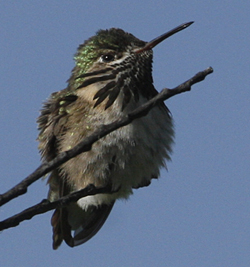 seen and we were starting to get the knack of sorting them out from the Cliff Swallows that we were seeing around river culverts. Our next stop was at the Jackson Airport where we hoped to find Sage Grouse. Several of us took the opportunity to study the flowers that grew among the sage and we noticed a helicopter checking us out from above. We moved on to Antelope Flats where we were able to study the field marks of Savannah and Brewer’s Sparrow. The hundreds of Bison were a real distraction but we managed to find Swainson’s Hawk, Northern Harrier, Sage Thrasher, Northern Flicker, and a few Pronghorn roaming the open range. On our way out of the area an American Kestrel flew and perched on the power lines near the road. A pair of Mountain Bluebirds at a nest box gave excellent views and the brilliant blue male was a hit with the photographers in the group. seen and we were starting to get the knack of sorting them out from the Cliff Swallows that we were seeing around river culverts. Our next stop was at the Jackson Airport where we hoped to find Sage Grouse. Several of us took the opportunity to study the flowers that grew among the sage and we noticed a helicopter checking us out from above. We moved on to Antelope Flats where we were able to study the field marks of Savannah and Brewer’s Sparrow. The hundreds of Bison were a real distraction but we managed to find Swainson’s Hawk, Northern Harrier, Sage Thrasher, Northern Flicker, and a few Pronghorn roaming the open range. On our way out of the area an American Kestrel flew and perched on the power lines near the road. A pair of Mountain Bluebirds at a nest box gave excellent views and the brilliant blue male was a hit with the photographers in the group.
We made our way back to Lupine Meadows and a secret parking lot where two Clark’s Nutcrackers were seen perched high in the pines. Gina and Steve were planning a hike up to find Calliope Hummingbirds but we only needed to take a few steps before we found a pair with a lovely male doing its display flight. We watched the bird for several minutes doing its loop flight and descending flutter. It was an incredible show. We got back in the vans and moved to a larger parking area where a Bull Moose with antlers cloaked in velvet was an impressive sight. We took a picnic lunch at String Lake where a pair of Steller’s Jays stole the show.
We left the Tetons and continued on to Yellowstone National Park first established in 1872 as the flagship national park in the US. We entered the park from the south and drove along the eastern shore of Lewis Lake following the Lewis River northward. The landscape still showed signs of the devastating fires of the late 1980’s but regeneration was evident with acres of six- to eight-foot Lodgepole Pines. To the east we could see the magnificent Absaroka Mountains and the 10,308-foot 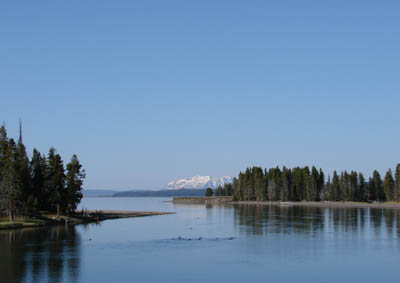 peak of Mount Sheridan. We made our way up to the Yellowstone Lake Lodge, the oldest building in the park. The bright yellow buildings and cabins looked stark from the outside but were quite nice on the inside. While waiting to settle into our rooms, a White-tailed Deer walked through the compound. We settled in and enjoyed a lovely dinner at the lodge before heading back out on an evening drive. It wasn't long before we encountered our first “bear jam” with a female Grizzly Bear and two cubs moving in the forest at the edge of a sagebrush field. We spent some time trying to get better views of the cubs and could see them as they frolicked among the fallen trees. We moved on to the Fishing Bridge where we saw a River Otter swimming toward the lake. We continued on to Pelican Creek where a Muskrat was seen feeding on the edge of the marsh. A pair of Western Grebe gave good looks as did a Common Merganser. We turned around here and headed into the Hayden Valley where there were several pullouts overlooking the Yellowstone River as it meandered northward through the vast open valley. peak of Mount Sheridan. We made our way up to the Yellowstone Lake Lodge, the oldest building in the park. The bright yellow buildings and cabins looked stark from the outside but were quite nice on the inside. While waiting to settle into our rooms, a White-tailed Deer walked through the compound. We settled in and enjoyed a lovely dinner at the lodge before heading back out on an evening drive. It wasn't long before we encountered our first “bear jam” with a female Grizzly Bear and two cubs moving in the forest at the edge of a sagebrush field. We spent some time trying to get better views of the cubs and could see them as they frolicked among the fallen trees. We moved on to the Fishing Bridge where we saw a River Otter swimming toward the lake. We continued on to Pelican Creek where a Muskrat was seen feeding on the edge of the marsh. A pair of Western Grebe gave good looks as did a Common Merganser. We turned around here and headed into the Hayden Valley where there were several pullouts overlooking the Yellowstone River as it meandered northward through the vast open valley.
From one of the pullouts, we scoped two Bald Eagles, several American Elk, a few Bison, Lesser Scaup, Cinnamon Teal, Green-winged Teal, American Wigeon, and some Canada Geese. As the sun set, we felt the evening chill and reflected on another wonderful day.
Day 5
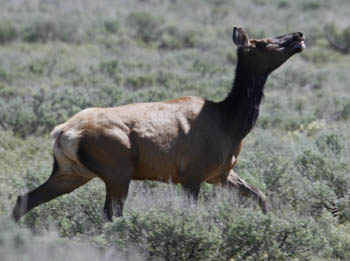 This morning after breakfast we headed back to the Hayden Valley. A mini “Bison jam” stopped us on the road as we drove toward the second pullout. We scanned the far hillside and saw two Grizzly Bears traversing the hill toward a herd of American Elk. This morning after breakfast we headed back to the Hayden Valley. A mini “Bison jam” stopped us on the road as we drove toward the second pullout. We scanned the far hillside and saw two Grizzly Bears traversing the hill toward a herd of American Elk.
The elk soon caught wind of the bears and moved nervously out toward the meadow as the bears disappeared into the wood.
As we drove through the valley we passed a large flock of Cliff Swallows gathering mud from the edge of a pond that was drying up. Another pullout stop produced several Barrow’s Goldeneye, a Coyote, more Canada Geese, and close looks at large Cutthroat Trout in the river. A Great Blue Heron waded along the distant shore and Spotted Sandpipers announced their breeding territory. We watched a large Bison dunk itself in the water and then shake it off on the shore.
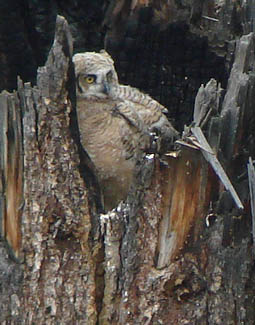 From here we moved on to the Tower Falls area, named for the 132-ft waterfall that empties into the Yellowstone River. The Yellowstone General Store here became one of our regular stops for coffee and shopping for the next several days. In the pines near the parking lot, a nice MacGillivray’s Warbler sang and then showed well. A Northern Flicker flew in to the same area as did a Western Tanager and another Three-toed Woodpecker. We were alerted to a Great Horned Owl nest and were able to scope two chicks right from the parking area. We moved on to a cliff face that overhung the road and found White-throated Swifts flying among a Violet-green Swallow colony. We enjoyed nice views of these birds from above and below. We also saw an Osprey nest on a pinnacle below and a Prairie Falcon perched on a ledge across the canyon. From here we moved on to the Tower Falls area, named for the 132-ft waterfall that empties into the Yellowstone River. The Yellowstone General Store here became one of our regular stops for coffee and shopping for the next several days. In the pines near the parking lot, a nice MacGillivray’s Warbler sang and then showed well. A Northern Flicker flew in to the same area as did a Western Tanager and another Three-toed Woodpecker. We were alerted to a Great Horned Owl nest and were able to scope two chicks right from the parking area. We moved on to a cliff face that overhung the road and found White-throated Swifts flying among a Violet-green Swallow colony. We enjoyed nice views of these birds from above and below. We also saw an Osprey nest on a pinnacle below and a Prairie Falcon perched on a ledge across the canyon.
We drove up over Mount Washburn and had lunch at Dunraven Pass at 8,859 feet. All the while being vigilant about bears, we heard a Pine Grosbeak in the tree tops but were never able to get a glimpse of it. We moved on to the Grand Canyon of the Yellowstone River and checked out the Upper and Lower Falls. A stop at LeHardy Rapids was a bit of a disappointment as there were no Harlequin Ducks to be found. However, there was a very close California Gull there feeding on a large trout.
We made our way back to the Lake Lodge with a little time to take in the largest high elevation lake in North America at 7,733 feet. We enjoyed another wonderful meal in the main lodge overlooking the lake and then went out for an evening drive. This time we found an American Dipper, another River Otter, more Barrow’s Goldeneye, and another Bison swimming in the river.
Day 6
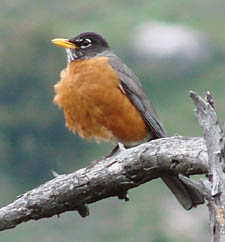 Today was another crystal clear, sunny morning and after breakfast we went out to the Fishing Bridge once again. In a slough at the river’s edge, we found a few Greater Scaup. A Common Loon fished in the open water and several Barrow’s Goldeneye were seen and then spooked by an unwelcome kayaker. We noticed several American Robins scolding in some pines along the edge and soon discovered that the disturbance was being caused by a Raven stealing a young robin from a nest. There were White-crowned Sparrows in the pines as well. A flyover Sandhill Crane distracted us from the robin massacre and then a Belted Kingfisher flew over calling as it went. A Great Blue Heron came in and worked a grassy area at the edge of the river. Clark’s Nutcrackers and Cassin’s Finches challenged us from the treetops and we saw several Cutthroat Trout in the water below the bridge. Today was another crystal clear, sunny morning and after breakfast we went out to the Fishing Bridge once again. In a slough at the river’s edge, we found a few Greater Scaup. A Common Loon fished in the open water and several Barrow’s Goldeneye were seen and then spooked by an unwelcome kayaker. We noticed several American Robins scolding in some pines along the edge and soon discovered that the disturbance was being caused by a Raven stealing a young robin from a nest. There were White-crowned Sparrows in the pines as well. A flyover Sandhill Crane distracted us from the robin massacre and then a Belted Kingfisher flew over calling as it went. A Great Blue Heron came in and worked a grassy area at the edge of the river. Clark’s Nutcrackers and Cassin’s Finches challenged us from the treetops and we saw several Cutthroat Trout in the water below the bridge.
We moved on to Pelican Creek and were greeting by the winnowing calls of a Wilson’s Snipe doing its flight display over the marsh. We watched the bird for several minutes as it kept making passes in the sky. Over the open water, we noted an Osprey and a Double-crested Cormorant. The Western Grebe was in the same spot as last night and American Wigeon and White Pelicans floated in the open areas. A Peregrine Falcon perched on a log at one end of the marsh and never moved the whole time we were there.
We went back and checked out of our Lake Lodge cabins, spending a few minutes looking at Cassin’s Finch, Tree Swallow, Cliff Swallow as we loaded the vans. We made a stop at Bridge Bay Marina for Lesser Scaup, and some confiding Barn Swallows gave us good views. California Gulls flew above and a Bufflehead dove at the far edge of the bay. Across the way, we drove near the lake edge with more Bufflehead and Barrow’s Goldeneye nearby. On the way out, Steve spotted a Western Wood-Pewee which we all came back for and enjoyed good looks at the top of a tree.
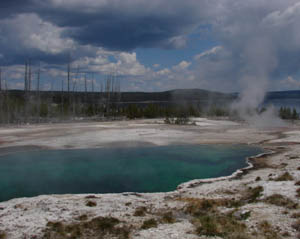 We continued on to the West Thumb Geyser Basin. We wandered among the hot pools and several of us agreed that the Black Pool should have a more colorful name and the Abyss Pool should have been called Black Pool. Nonetheless it was our first real look at some of the 10,000 or so thermal features at Yellowstone. It was a good warm up for Old Faithful where we stopped next. We had lunch at the picnic area and then took advantage of some time between eruptions to explore the area. Some of us walked the boardwalks and trails while others looked at the plants and flowers that grew in the geyser basin. We met for a group photo next to the Old Faithful Geyser sign. Another eruption was due in a few minutes so we stayed to enjoy it, noting that it was actually better that the one we had seen earlier. We continued on to the West Thumb Geyser Basin. We wandered among the hot pools and several of us agreed that the Black Pool should have a more colorful name and the Abyss Pool should have been called Black Pool. Nonetheless it was our first real look at some of the 10,000 or so thermal features at Yellowstone. It was a good warm up for Old Faithful where we stopped next. We had lunch at the picnic area and then took advantage of some time between eruptions to explore the area. Some of us walked the boardwalks and trails while others looked at the plants and flowers that grew in the geyser basin. We met for a group photo next to the Old Faithful Geyser sign. Another eruption was due in a few minutes so we stayed to enjoy it, noting that it was actually better that the one we had seen earlier.
From here we made our way toward West Yellowstone. At a turnout on Madison River we saw many Bison with calves on the flat lands next to the river. We also saw one female American Elk which never moved from its spot. A Savannah Sparrow challenged our identification skills and when we scoped an old eagle nest we found that it was now occupied by an Osprey. We enjoyed very close looks at Spotted Sandpiper along the river edge and noted a large Yellow-bellied Marmot as we checked back on the female Elk. We noted Canada Geese with goslings, the first we’d seen since Jackson, and a pair of Common Mergansers on the far shore. As we continued toward West Yellowstone, we stopped to look at a Bald Eagle nest very close to the road. As we scoped and watched, we noticed two large chicks on the nest and enjoyed these wonderful views for several minutes before heading to our hotel in West. We had an excellent meal at the Three Bears Restaurant and reviewed our day’s list in the cozy lounge at our hotel.
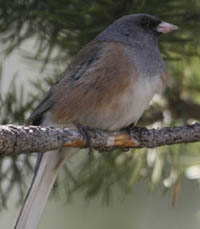 Day 7 Day 7
After breakfast, we headed west to explore some lesser-known wildlife areas west of Yellowstone Park. A roadside stop at a wetland area yielded Ring-necked Duck, Cinnamon Teal, and several Red-winged Blackbirds. Along the way we noted some Dark-phased Red-tailed Hawks flying and perched on posts. We reached the Continental Divide where water flows on the east side to the Atlantic or on the west side to the Pacific. We also happened to be on the border of Montana and Idaho. In the forest here, we found Mountain Chickadee, Red-breasted Nuthatch, Cassin’s Finch, Dark-eyed Junco, Common Raven, and the ever-present American Robin. We continued along the road and saw several more Red-tailed Hawks, two Sandhill Cranes walking in a large field, and a Long-billed Curlew in a field with some horses.
At Henry’s Fork of the Snake River, we saw a large colony of Cliff Swallows nesting on a bridge, a Bald Eagle perched in a tree up the river, and a beaver lodge. American Wigeon and Mallards were in the river, as well. We turned back to go to Henry’s Lake and along the way got nice looks at a Northern Flicker on a post, American Kestrel on a wire, and a Mountain Bluebird visiting a stream.
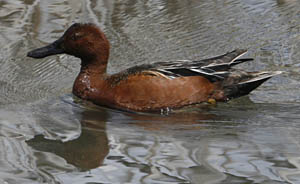 At Henry’s Lake, we picked up Ring-necked Ducks, Blue-winged Teal, and Cinnamon Teal. Song and Savannah Sparrows posed in the tall grasses for a plumage comparison while a Northern Harrier hunted the field across the road. Ring-billed Gull, Killdeer, Lesser Scaup, and Forster’s Tern were seen here as were American White Pelican and Red-necked Grebe. There was so much to scan and at one point Steve spotted a Badger moving near the road. Some of us got quick glimpses and we grabbed the scopes to try and find it again but it disappeared as quickly as it had appeared. We stopped at a small park with a boat ramp and scoped some distant Eared Grebes. As we were about to leave, a Yellow-headed Blackbird flew over and landed in the reeds. At Henry’s Lake, we picked up Ring-necked Ducks, Blue-winged Teal, and Cinnamon Teal. Song and Savannah Sparrows posed in the tall grasses for a plumage comparison while a Northern Harrier hunted the field across the road. Ring-billed Gull, Killdeer, Lesser Scaup, and Forster’s Tern were seen here as were American White Pelican and Red-necked Grebe. There was so much to scan and at one point Steve spotted a Badger moving near the road. Some of us got quick glimpses and we grabbed the scopes to try and find it again but it disappeared as quickly as it had appeared. We stopped at a small park with a boat ramp and scoped some distant Eared Grebes. As we were about to leave, a Yellow-headed Blackbird flew over and landed in the reeds.
We made our way to the massive expanse of Red Rocks National Wildlife Refuge and got good looks at two male Northern Harriers hunting the open prairie and a Long-billed Curlew in a meadow. We found a nice picnic spot near the shore of a large lake. A Black-headed Grosbeak serenaded us from the top of a tree as did a Willow Flycatcher. Yellow Warbler, Western Wood-Pewee, Hammond’s Flycatcher, and Lincoln’s and White-crowned Sparrow all shared the picnic area and we enjoyed good looks at them.
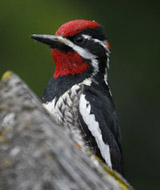 After lunch, we walked down toward the lake and enjoyed cracking views of two Cedar Waxwings posed in a tree above the trail. Some Western Warbling Vireos flew in and sang for us as well. On the lake, we scoped Eared Grebe, Franklin’s Gulls, and Canvasback. A pair of Trumpeter Swans with three cygnets were on view here as were Northern Shoveler, American Wigeon, American Coot, Double-crested Cormorant, American White Pelican, Western Grebe, Ruddy Duck, and Lesser Scaup. After lunch, we walked down toward the lake and enjoyed cracking views of two Cedar Waxwings posed in a tree above the trail. Some Western Warbling Vireos flew in and sang for us as well. On the lake, we scoped Eared Grebe, Franklin’s Gulls, and Canvasback. A pair of Trumpeter Swans with three cygnets were on view here as were Northern Shoveler, American Wigeon, American Coot, Double-crested Cormorant, American White Pelican, Western Grebe, Ruddy Duck, and Lesser Scaup.
At Red Rocks pass, we stopped and walked some trails. Gina spotted a Mountain Lion track which was very exciting, while Steve was stalked by a territorial Red-naped Sapsucker. The sapsucker drummed on several trees and we all enjoyed listening to the drumming resonate down the entire in the tree. We moved down the road slowly and picked up Hairy Woodpecker, Least Flycatcher, Olive-sided Flycatcher, and White-crowned Sparrow. We headed back to West Yellowstone and another great dinner at the Three Bears.
Day 8
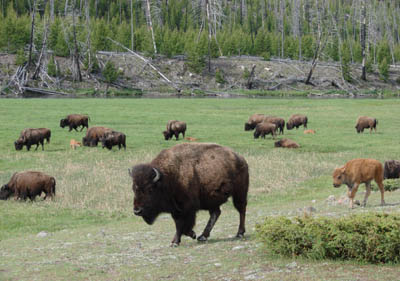 This morning after breakfast we headed back into Yellowstone National Park through the west entrance. We drove along the Madison River and came upon a large Bison jam with several young calves. We watched the spectacle from a pullout as Bison after Bison walked by the vans right through the parking lot. The herd stretched in either direction and we enjoyed great looks at the frisky calves from the safety of our vehicles. When we had our fill, we continued on to the Gibbon Falls pullout to admire the steep canyon. Below in the river, an American Dipper sat on a rock. Eileen saw another Dipper working up the falls. Overhead, a Red-tailed Hawk soared and an Osprey flew by. This morning after breakfast we headed back into Yellowstone National Park through the west entrance. We drove along the Madison River and came upon a large Bison jam with several young calves. We watched the spectacle from a pullout as Bison after Bison walked by the vans right through the parking lot. The herd stretched in either direction and we enjoyed great looks at the frisky calves from the safety of our vehicles. When we had our fill, we continued on to the Gibbon Falls pullout to admire the steep canyon. Below in the river, an American Dipper sat on a rock. Eileen saw another Dipper working up the falls. Overhead, a Red-tailed Hawk soared and an Osprey flew by.
We then drove to the Swan Lake Flats pullout and scoped Swan Lake. From a distance it seemed empty, but we soon spotted a group of five Wilson’s Phalaropes and two Red-necked Phalaropes on the lake. At the far end were Lesser Scaup and American Wigeon. Steve spotted a Bald Eagle perched on a tree across the valley.
Further on, we stopped at the Hoodoos for a scenery shot. Anne, Meg, and Liz immediately got out of the van to look at the flowers around these unique rock formations. As we admired a lovely primrose, a car pulled up and drew our attention to a Mountain Goat on the opposite hill. We scoped it and though it was distant, we got a pretty good view of this rare animal.
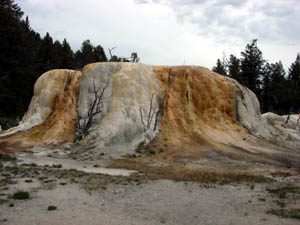 Our next stop was Mammoth Hot Springs where we drove the Upper Terrace Road marveling at the milky white and porcelain finished springs. We had a picnic lunch at Mammoth Picnic area and some time for enjoying the lower terraces, shops, and visitor center. As we gathered at the vans, we noticed a crowd gathering by a hillside. Upon investigation, we found a rather large Gopher Snake hiding in a rock outcropping. Our next stop was Mammoth Hot Springs where we drove the Upper Terrace Road marveling at the milky white and porcelain finished springs. We had a picnic lunch at Mammoth Picnic area and some time for enjoying the lower terraces, shops, and visitor center. As we gathered at the vans, we noticed a crowd gathering by a hillside. Upon investigation, we found a rather large Gopher Snake hiding in a rock outcropping.
From here, we went to the 45th Parallel Bridge midway between the equator and the north pole. It wasn't long until Steve motioned to us to come into the sagebrush field by the edge of the river to see a gorgeous male Lazuli Bunting singing from a perch. We watched this splendid bird for several minutes and then a female appeared for all to see. The birds posed for photos and the brilliant blue male brightened up the landscape. Stunning!
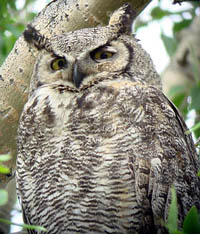 We continued on to Blacktail Ponds noticing that the skies had clouded up and were threatening rain. From the pullout, we scoped an area where we had seen Wilson’s Phalarope fly in but were unable to pick them up again. We were able to see Pied-billed Grebe, Sandhill Cranes, Lesser Scaup, Green-winged Teal, Bufflehead, Yellow-headed Blackbirds, Ruddy Ducks, Killdeer, and Spotted Sandpipers on the ponds. A Pronghorn grazed the surrounding fields and we could see a Canada Goose family moving toward the edge of the pond. Some rain drops began to fall so we loaded into the vans and headed back toward Mammoth. As we drove into town, we could see some birders in a parking lot scoping something in some trees near the visitor center. We investigated and found an adult Great Horned Owl perched in a tree right over the road. We searched at bit and found its nest and got an obscured view of a fluffy chick. Black-capped Chickadees and Warbling Vireos worked adjacent trees seemingly uninterested in the owl. We continued on to Blacktail Ponds noticing that the skies had clouded up and were threatening rain. From the pullout, we scoped an area where we had seen Wilson’s Phalarope fly in but were unable to pick them up again. We were able to see Pied-billed Grebe, Sandhill Cranes, Lesser Scaup, Green-winged Teal, Bufflehead, Yellow-headed Blackbirds, Ruddy Ducks, Killdeer, and Spotted Sandpipers on the ponds. A Pronghorn grazed the surrounding fields and we could see a Canada Goose family moving toward the edge of the pond. Some rain drops began to fall so we loaded into the vans and headed back toward Mammoth. As we drove into town, we could see some birders in a parking lot scoping something in some trees near the visitor center. We investigated and found an adult Great Horned Owl perched in a tree right over the road. We searched at bit and found its nest and got an obscured view of a fluffy chick. Black-capped Chickadees and Warbling Vireos worked adjacent trees seemingly uninterested in the owl.
We drove through Gardner Canyon and stopped at a pullout to look at Bighorn Sheep on the steep hillside above the road. Among the rocks were four females and a lamb and possibly more that we could not see hidden among the large boulders. We continued into Gardner through the Roosevelt Arch at the park’s north entrance and checked into our hotel on Hellroaring Street. After a nice dinner, we took an evening drive back into the park. Just inside the arch, we spotted a Desert Cottontail near some buildings. An obliging Pronghorn posed for numerous photographs. At the pullout, the Bighorn Sheep were closer to the road than before and one female had at least five lambs with her. We passed a Bison herd, noting some frisky ones sparring and one taking a dust bath. A Coyote hunted among the sagebrush and we enjoyed looks at a very close American Elk.
Day 9
An early thunder and hail storm canceled our pre-breakfast birding plans so we checked out of Gardiner after breakfast and headed toward the Lamar Valley. As we gathered in the parking lot, a Franklin’s Gull flew over followed by an Osprey. We drove through Roosevelt Arch and through Mammoth under bright skies but as we headed east, clouds filled the sky.
We stopped at Undine Falls and found a Hammond’s Flycatcher building a nest. Hairy Woodpecker, Pine Siskin, Osprey, and American Crow were all seen from the canyon side pullout. We continued on and by the time we reached Tower Falls, rain was steady and heavy. We traveled through the Lamar Valley in a downpour and reached Dan Hartman’s Gallery just before lunch. We made plans to return for a program on owls later in the afternoon and went on to Cooke City to check into our hotel.
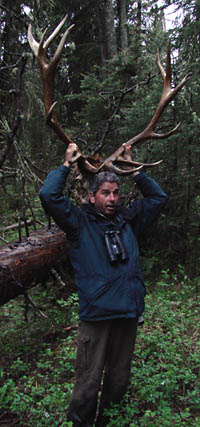 In mid-afternoon, we drove back to Dan’s through snowflakes as big as tennis balls and enjoyed home-baked cookies and coffee while hearing about Dan’s experiences as a photographer and naturalist in Yellowstone. Cindy soon interrupted us with a report of a Black Rosy-Finch at the feeder and some of us caught a quick glimpse. Back to Dan’s slide show, we enjoyed fantastic photos of the Yellowstone wolves and listened to Dan’s stories. Once again Cindy interrupted with a Rosy-Finch report and this time it was joined by a female Pine Grosbeak. We headed up to Sammi’s Saloon for dinner and then some of us met up with Dan again for an evening hike in the Lamar Valley in search of Great Gray Owls. The snow and rain had let up somewhat and we worked our way up through some rain-soaked meadows and fir forests. There were several piles of bear scat and a few bear trees along our route which made it especially exciting. We did not find any Great Grays but did find an impressive carcass of a bull elk with a huge antler rack. In mid-afternoon, we drove back to Dan’s through snowflakes as big as tennis balls and enjoyed home-baked cookies and coffee while hearing about Dan’s experiences as a photographer and naturalist in Yellowstone. Cindy soon interrupted us with a report of a Black Rosy-Finch at the feeder and some of us caught a quick glimpse. Back to Dan’s slide show, we enjoyed fantastic photos of the Yellowstone wolves and listened to Dan’s stories. Once again Cindy interrupted with a Rosy-Finch report and this time it was joined by a female Pine Grosbeak. We headed up to Sammi’s Saloon for dinner and then some of us met up with Dan again for an evening hike in the Lamar Valley in search of Great Gray Owls. The snow and rain had let up somewhat and we worked our way up through some rain-soaked meadows and fir forests. There were several piles of bear scat and a few bear trees along our route which made it especially exciting. We did not find any Great Grays but did find an impressive carcass of a bull elk with a huge antler rack.
Day 10
This morning we awoke to a landscape blanketed with snow. The snow covered trees were a surprise but we enjoyed this new perspective. We met Dan for an early run up the Beartooth Highway into the Shoshone National Forest. We started up the snow-covered road and, not far out of town, Meg spotted a “Mountain” fox (Vulpes vulpes macroura) in an open field. We turned around and all got fabulous views of this beautiful animal. We continued up to an area where Dan hoped to show us Great Gray Owl but dipped again on this bird. (Thankfully, we had those great looks near Jackson!) Dan heard a Ruffed Grouse drumming close to the road and we made our way through the snow and dense forest to see a lovely male displaying on a log. It stood for awhile and then drummed for us. Fantastic! On the way down the mountain, we stopped by a little pond where a lovely Hermit Thrush showed well and we got nice looks at an American Robin on a nest.
We enjoyed breakfast at the Grizzly Pad and then went to Dan’s feeders where there were at least eighty Black Rosy-Finches, several Pine Siskins, Cassin’s Finches, and Dark-eyed Juncos. It was great to see so many Rosy-Finches at close range! Below the feeding area, we got good looks at a Snowshoe Hare which had turned back to its summer coat but retained its white feet. The snow was quickly melting and we wanted to get back into the Lamar Valley while there was still some white on the ground. As we approached a pullout, a large, dark raptor flew along the river. It landed by the rivers edge and at first it looked like a Golden Eagle. When it flew again, it was obviously an immature Bald Eagle and as we were determining that another Badger scurried through the sagebrush by the river. Thrilled at another glimpse of this elusive animal, we scoped the area for several minutes but did not see the Badger again. We did find a Black Bear roaming the hillside and studied it for several minutes as a park ranger explained the finer points of bear identification.
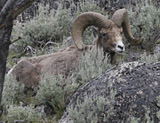 We made a comfort stop at Slough Creek and scanned the hills for wolves. Steve spotted a Grizzly Bear across the valley and we all got satisfying views of it. Up the valley, a Bald Eagle was being chased by a Red-tailed Hawk. We made a comfort stop at Slough Creek and scanned the hills for wolves. Steve spotted a Grizzly Bear across the valley and we all got satisfying views of it. Up the valley, a Bald Eagle was being chased by a Red-tailed Hawk.
We stopped by the Yellowstone River bridge to check for Harlequin Ducks. We were immediately distracted by two Bighorn Sheep rams resting among the sagebrush. Once again, we could not resist this great photo opportunity. Back on task, Steve spotted a pair of Harlequin Ducks on the river below us and we were thrilled to see this striking bird that we had missed at LeHardy Rapids.
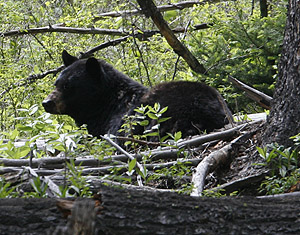 We moved on to Tower Falls for lunch and checked on the MacGillivray’s Warbler still singing in the pine. We scoped the Great Horned Owl nest where two chicks were showing very well perched on the edge of the snag. A Coyote moved across in the background and we followed it until it was out of sight. Leaving Tower Falls, we came around by Calcite Springs into a huge bear jam for “Rosie”, the 17-year-old female Black Bear. Rosie gave us wonderful views as she moved around the dead trees on the forest floor. A park ranger arrived and skillfully controlled the crowd that had gathered. When we had our fill, we moved on to Floating Island Lake. Here we found American Wigeon, Yellow-bellied Marmot, a female Common Goldeneye, a Ruddy Duck, Wilson’s Phalarope, Northern Rough-winged Swallows, Tree Swallows, Mallards with ducklings, Lesser Scaup, and Spotted Sandpiper. We moved on to Tower Falls for lunch and checked on the MacGillivray’s Warbler still singing in the pine. We scoped the Great Horned Owl nest where two chicks were showing very well perched on the edge of the snag. A Coyote moved across in the background and we followed it until it was out of sight. Leaving Tower Falls, we came around by Calcite Springs into a huge bear jam for “Rosie”, the 17-year-old female Black Bear. Rosie gave us wonderful views as she moved around the dead trees on the forest floor. A park ranger arrived and skillfully controlled the crowd that had gathered. When we had our fill, we moved on to Floating Island Lake. Here we found American Wigeon, Yellow-bellied Marmot, a female Common Goldeneye, a Ruddy Duck, Wilson’s Phalarope, Northern Rough-winged Swallows, Tree Swallows, Mallards with ducklings, Lesser Scaup, and Spotted Sandpiper.
Above the lake on the hill was another Black Bear in very nice condition. We watched for a few minutes and a small cub appeared and followed it across the hillside! On the way back to Cooke City, Gina stopped the van and turned around to look at a Moose feeding in front of a home. Steve said it was feeding on “Muesli” and from then on all the Moose we saw were dubbed Muesli.
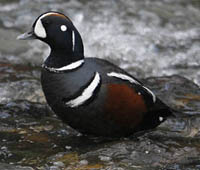 Later we did an evening run from Cooke City into the park from the Northeast entrance. Just before the Soda Butte Creek picnic area, Kate spotted another pair of Harlequin Ducks on the river. Close to the road, these birds proved easy to photograph. Further into the park, we stopped at the Coyote den to find six pups frolicking by the entrance and two beleaguered-looking adults trying to keep track of them. On the other side of the road, Steve spotted a large Moose with a calf which looked like a miniature version of the adult so we dubbed it “mini-Moose”. A quick comfort stop yielded close looks at Cliff Swallows nesting on the outhouse building. We stopped at a beaver pond and found the Beaver feeding on small wetland plants in its flooded pond. In the river across the road were a few Common Mergansers and several Canada Geese with goslings. Later we did an evening run from Cooke City into the park from the Northeast entrance. Just before the Soda Butte Creek picnic area, Kate spotted another pair of Harlequin Ducks on the river. Close to the road, these birds proved easy to photograph. Further into the park, we stopped at the Coyote den to find six pups frolicking by the entrance and two beleaguered-looking adults trying to keep track of them. On the other side of the road, Steve spotted a large Moose with a calf which looked like a miniature version of the adult so we dubbed it “mini-Moose”. A quick comfort stop yielded close looks at Cliff Swallows nesting on the outhouse building. We stopped at a beaver pond and found the Beaver feeding on small wetland plants in its flooded pond. In the river across the road were a few Common Mergansers and several Canada Geese with goslings.
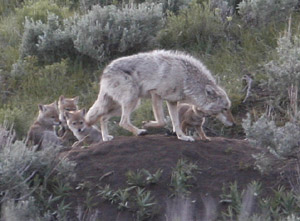 Day 11 Day 11
Our mission today was to find Gray Wolves in Yellowstone Park, so we set off early to the Lamar Valley to search the vast open areas. We spotted two distant Black Bears and a couple of Coyotes that we tried to make into wolves but, after watching them for awhile, it was clear that they were not. We scanned the open landscape spotting American Magpies, Sandhill Cranes, and Spotted Sandpipers. Two Coyote pups were visible at the den near Pebble Creek. We worked our way over to Tower, encountering another Black Bear jam along the way. We stopped at a picnic area and scoped a Dusky Flycatcher while Red-tailed Hawks and White throated Swift flew overhead. Continuing on we worked our way up toward Mount Washburn passing several people scoping the valley below. We stopped at a makeshift pullout and set up our own scopes on three pale wolves from the Agate pack. The views were quite distant but exciting when the wolves lifted their heads and moved. Soon we realized that there were three dark wolves as well a little to the left. Six wolves – distant looks but exciting nonetheless. In a different part of the valley we could see a Moose in the pine forest.
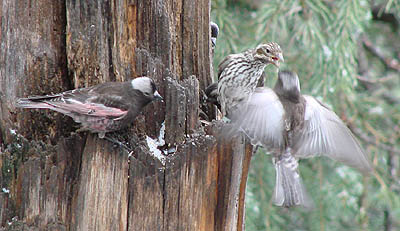 Pleased with our finds, we went back to Tower Falls for lunch and coffee. The owl chicks were still there and some of us enjoyed last looks at the falls. We worked our way back through the Lamar Valley and stopped once more at Dan’s feeders where Hairy Woodpecker, Cassin’s Finch, Red-breasted Nuthatch, Pine Siskins were all feeding. Cindy had found a Fairy Slipper orchid and shared it with Anne and the other botanists in our group. We walked up behind Dan’s house a short distance and found some Wolf scat on the driveway – a bit of a surprise to Dan. As we bid goodbye to the Hartman’s a Broad-tailed Hummingbird buzzed by and fed on flowers in pots hanging by the gallery door. On the way back to Cooke City, we stopped for three Moose in a riparian area near a pullout. Pleased with our finds, we went back to Tower Falls for lunch and coffee. The owl chicks were still there and some of us enjoyed last looks at the falls. We worked our way back through the Lamar Valley and stopped once more at Dan’s feeders where Hairy Woodpecker, Cassin’s Finch, Red-breasted Nuthatch, Pine Siskins were all feeding. Cindy had found a Fairy Slipper orchid and shared it with Anne and the other botanists in our group. We walked up behind Dan’s house a short distance and found some Wolf scat on the driveway – a bit of a surprise to Dan. As we bid goodbye to the Hartman’s a Broad-tailed Hummingbird buzzed by and fed on flowers in pots hanging by the gallery door. On the way back to Cooke City, we stopped for three Moose in a riparian area near a pullout.
We had some free time in Cooke City and then met for a fabulous dinner at the Beartooth Café.
Day 12
After breakfast we headed up the Beartooth Highway in the hopes that Beartooth Pass was open and we could get through to Red Lodge and eventually Billings. A quick stop at a camping area yielded Dark-eyed Junco and Hairy Woodpecker. Along the road, another Mountain Red Fox was spotted and a close Ruffed Grouse perched in a tree for several minutes. Liz spotted a Yellow-bellied Marmot on the side of the road – the best close view we’d had.
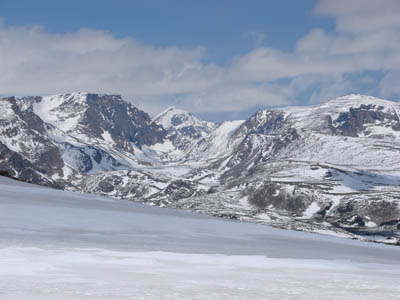 We stopped at a scenic overlook where a few Clark’s Nutcrackers were perched in the tree tops. Here we found Cassin’s Finch, Red-naped Sapsucker, House Wren, Tree Swallows, and a Red-tailed Hawk soaring above the peaks. An aspen grove yielded Red-breasted Nuthatch, Northern Flicker, and Mountain Bluebird. We stopped at the Top of the World (population: 8) for coffee and continued on, passing several lakes including Long Lake where we got out to enjoy the spectacular scenery. Above the tree line was a sprawling snow-covered landscape and we were in awe as we continued to climb in altitude. At the top, Steve found a few Black Rosy-Finches in their native habitat and we spotted some American Pipits on the snow. We made another scenery stop at Rock Creek Vista Point at an elevation of 9,190 ft and began to descend into the Custer National Forest. We made our way to Red Lodge for lunch and then continued to Billings, noting the dramatic change in the landscape as the mountains disappeared behind us and rolling hills and flat prairies lay ahead. An exciting moment came when a train passed near the road way, flushing a Great Blue Heron out of a ditch right in front of us. Western Meadowlarks were common now and we could hear their songs from the bus and whenever we stopped. We stopped at a scenic overlook where a few Clark’s Nutcrackers were perched in the tree tops. Here we found Cassin’s Finch, Red-naped Sapsucker, House Wren, Tree Swallows, and a Red-tailed Hawk soaring above the peaks. An aspen grove yielded Red-breasted Nuthatch, Northern Flicker, and Mountain Bluebird. We stopped at the Top of the World (population: 8) for coffee and continued on, passing several lakes including Long Lake where we got out to enjoy the spectacular scenery. Above the tree line was a sprawling snow-covered landscape and we were in awe as we continued to climb in altitude. At the top, Steve found a few Black Rosy-Finches in their native habitat and we spotted some American Pipits on the snow. We made another scenery stop at Rock Creek Vista Point at an elevation of 9,190 ft and began to descend into the Custer National Forest. We made our way to Red Lodge for lunch and then continued to Billings, noting the dramatic change in the landscape as the mountains disappeared behind us and rolling hills and flat prairies lay ahead. An exciting moment came when a train passed near the road way, flushing a Great Blue Heron out of a ditch right in front of us. Western Meadowlarks were common now and we could hear their songs from the bus and whenever we stopped.
We arrived Billings in mid-afternoon. After settling into our rooms, we picked up Helen Carlson, a veteran birder and expert for this area, to do some late day birding. We gave Helen the list of species we were after and at our first stop we immediately started ticking things off. At Lake Elmo Park, a nice Clark’s Grebe was spotted in with some Western Grebes. An Osprey flew over and Spotted Sandpiper flew across the lake. We then went to Two Moon Park in Billings, a lovely natural area along the Yellowstone River that Helen helped created in the 1970s. Yellow Warblers greeted us with their songs in the parking lot and we got good looks at Black-headed Grosbeak and House Wren at the trail head. A Song Sparrow showed well as did a pair of Swainson’s Thrushes. A vocal Yellow-breasted Chat gave us a nice show as did an American Redstart, and a Red-eyed Vireo singing above our heads. As we looked up at the vireo we could see nearly a dozen Common Nighthawks flying high in the sky. A few Cedar Waxwings were seen and we heard several Ring-necked Pheasants.
We went back to our hotel and went out for an excellent evening meal at a local steakhouse.
Day 13
We got an early start this morning to explore prairie habitat northwest of Billings. On the way to pick up Helen, we saw a Mule Deer which looked out of place on the suburban street. In Helen’s yard, a Common Grackle graced her feeder and a pair of Mallards walked along the lush grass. Around the corner from Helen’s house, Steve spotted “Tom”, the local male Wild Turkey, and then we found the female a block or so away.
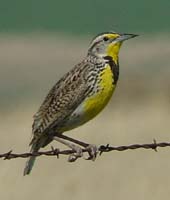 At a fuel stop, Gina spotted several Chimney Swifts flying overhead. We worked our way along Highway 3 and made a stop at a small pond that held American Avocet, Wilson’s Phalarope, Blue-winged Teal, and a Killdeer with a baby working along the edge. Horned Larks flitted near the railroad track on the other side of the road, giving us our first good looks at this species. At a fuel stop, Gina spotted several Chimney Swifts flying overhead. We worked our way along Highway 3 and made a stop at a small pond that held American Avocet, Wilson’s Phalarope, Blue-winged Teal, and a Killdeer with a baby working along the edge. Horned Larks flitted near the railroad track on the other side of the road, giving us our first good looks at this species.
Further on, Steve spotted a Ferruginous Hawk perched on a power stanchion. As we watched it, we noticed that it was carrying a stick and eventually it flew to its nest on another stanchion. In the field beyond the railroad tracks we could see several Lark Buntings in display flights. Western Meadowlarks were common and perched on many fence posts. On another stanchion, we spotted a Golden Eagle.
We pulled over at a Black-tailed Prairie Dog town to check it out. We scanned the many mounds and eventually found a Burrowing Owl among the Prairie Dogs. Steve spotted an Eastern Kingbird on a wire along the road side and we all got good views.
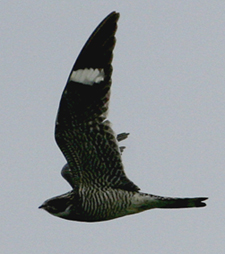 Eventually we reached Broadview and left the paved road for a dirt road that traversed the prairie. Horned Larks were common on the fences and a Northern Harrier was spotted hunting over a field. We stopped in one area and found a Clay-colored Sparrow on the fence and some displaying McCown’s Longspurs in the adjacent field. We got excellent looks at the display flights of three or four males, but the real treat was when one perched close on a wire allowing us all excellent views. As we admired the Longspur, a large flock of Cliff Swallows flew low over the field causing a bit of a distraction. Some Mourning Doves came through as well. Eventually we reached Broadview and left the paved road for a dirt road that traversed the prairie. Horned Larks were common on the fences and a Northern Harrier was spotted hunting over a field. We stopped in one area and found a Clay-colored Sparrow on the fence and some displaying McCown’s Longspurs in the adjacent field. We got excellent looks at the display flights of three or four males, but the real treat was when one perched close on a wire allowing us all excellent views. As we admired the Longspur, a large flock of Cliff Swallows flew low over the field causing a bit of a distraction. Some Mourning Doves came through as well.
Further on, we stopped at a ranch. As we pulled into the driveway, a Great Horned Owl flew low out of a tree with American Robins in hot pursuit. Just barely catching glimpses of that, we were distracted by a Gray Partridge running up the track. Say’s Phoebe and Eastern Kingbird were also seen here, as was a Common Nighthawk that flew through and then perched on a horizontal branch allowing us close looks.
When we finished here, we moved across the road to a small pond that held Yellow-headed and Red-winged Blackbirds, American Coot, Cinnamon Teal, Blue-winged Teal, more Swallows, Northern Shoveler, and a Mallard with young. We continued on the dusty road for awhile when Gina shouted “Short-eared Owl on the left”, and we could see the butterfly-like flight of the bird as it coursed over a field. A Lark Sparrow gave us a quick view 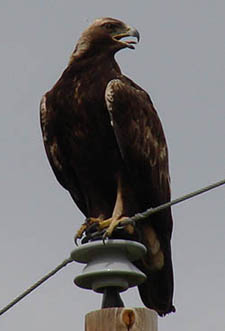 as it flitted from a fence. Western Wood-Pewee was also seen on a fence and a Swainson’s Hawk gave us a close view as it perched on a telephone pole. A Ring-necked Pheasant scurried over a fence and disappeared in the grass. We turned a corner where several Lark Buntings were working some shrubs close to the road. All at once, a Marbled Godwit flew into the road in front of us. Then another flew alongside over an open field. Ahead we stopped at another Black-tailed Prairie Dog colony and across the road, a Burrowing Owl sat on a close post giving great views. as it flitted from a fence. Western Wood-Pewee was also seen on a fence and a Swainson’s Hawk gave us a close view as it perched on a telephone pole. A Ring-necked Pheasant scurried over a fence and disappeared in the grass. We turned a corner where several Lark Buntings were working some shrubs close to the road. All at once, a Marbled Godwit flew into the road in front of us. Then another flew alongside over an open field. Ahead we stopped at another Black-tailed Prairie Dog colony and across the road, a Burrowing Owl sat on a close post giving great views.
We continued on to Hailstone Wildlife Refuge to a large pond which held Eared Grebe, Northern Shoveler, more American Avocets, Wilson’s Phalarope, Northern Pintail, Redhead, Canvasback, Lesser Scaup, Ruddy Ducks, and a Willet. A distant Coyote carried what looked like a Prairie Dog in its mouth. A distant Golden Eagle was scoped and we noted Ring-billed Gull for our list. Back on the main road, we stopped to see a Golden Eagle on a power pole right along the road. The best views yet!
We stopped for lunch in the very small town of Rapalje and met some lovely people in the restaurant who taught us a thing or two about local cuisine. On the way back, we spotted a juvenile Ferruginous Hawk, another Gray Partridge, and several Richardson’s Ground Squirrels on the road. A Prairie Falcon flew by as we drove along. In a water-filled ditch, three Wilson’s Phalaropes gave close views and nice photos. On this corner of the road there were five or six Chestnut-collared Longspurs flying around as we got great views of them. A pair landed on the road less than twenty yards away! Off in the distance, a flock of eight Long-billed Curlews flew across the meadow.
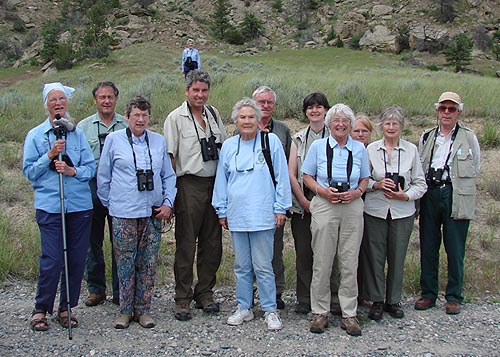 Further on, we stopped at a wind break that held a Loggerhead Shrike, Say’s Phoebe, Eastern Kingbird, a Mourning Dove on a nest, Cedar Waxwings, and a Common Nighthawk. As we were leaving, Helen spotted a Western Kingbird on a branch at the edge of the break. A Swainson’s Hawk was perched on a mound down the road giving us a chance to study its plumage. On the way back, we stopped at a lovely canyon area where we found a singing Canyon Wren. Further on, we stopped at a wind break that held a Loggerhead Shrike, Say’s Phoebe, Eastern Kingbird, a Mourning Dove on a nest, Cedar Waxwings, and a Common Nighthawk. As we were leaving, Helen spotted a Western Kingbird on a branch at the edge of the break. A Swainson’s Hawk was perched on a mound down the road giving us a chance to study its plumage. On the way back, we stopped at a lovely canyon area where we found a singing Canyon Wren.
We topped off this fantastic day with a visit to Helen’s house where she gave us a tour of her legendary bear collection. We bid a fond farewell to our friend and headed back to the hotel for some rest before our final dinner at an excellent steakhouse.
Day 14
After breakfast, we loaded the vans and headed to the Billings airport. We said our goodbyes as the group headed off for the long journey back to the UK with many fond memories and wonderful sightings. It was a pleasure traveling with this group and sharing the spectacular beauty and wildlife of the west. Thank you all for a great trip!
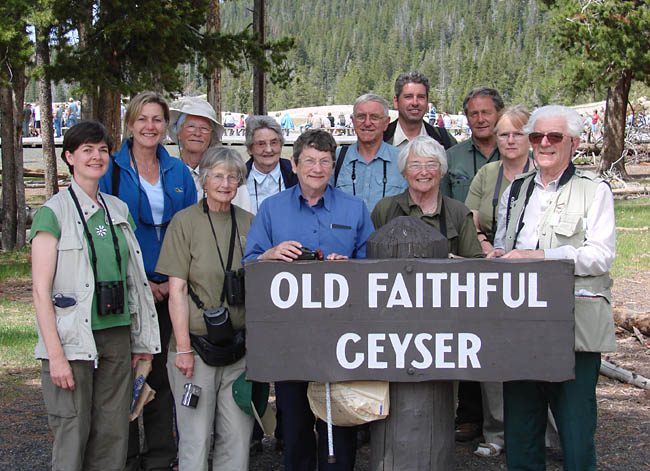
|
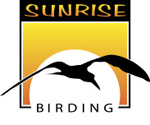
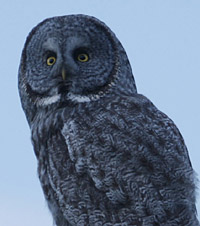 Montana, Yellowstone, & the Grand Tetons
Montana, Yellowstone, & the Grand Tetons
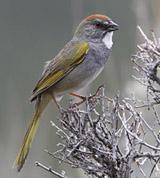
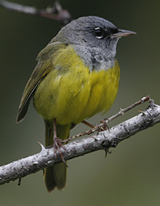

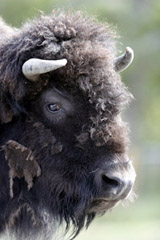
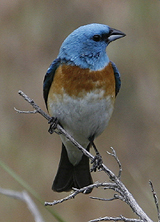
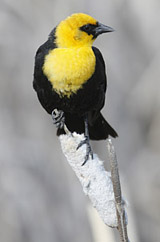


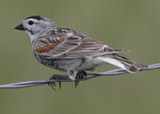
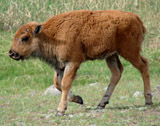

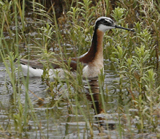
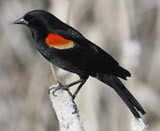
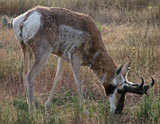
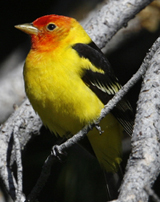
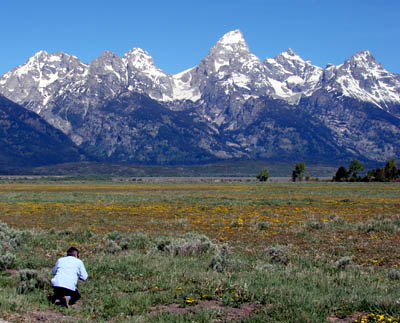 Montana, Yellowstone,
Montana, Yellowstone,
 We headed back down the mountain to the Fish Creek area. We stopped near a bridge over Fish Creek where we saw four Turkey Vultures lazily drifting along the ridge above. A nice Black-headed Grosbeak sang for us and showed well, and we were able to see Mountain Chickadee and Audubon’s Warbler in the thick branches of a large spruce by the side of the road. Further up the road, we got great looks at Green-tailed Towhee in low vegetation on a hillside. Yellow Warblers flitted among the shrubs along the stream and a Mourning Dove flew by. Broad-tailed Hummingbirds also buzzed around and one landed on a bare branch just up the hill so we could scope it. Its bright gorget glowed as it turned at the right angle to the light garnering “wows” from the crowd. An Olive-sided Flycatcher was also spotted up the hill and across the river a female Red Crossbill perched high atop a tree. We traveled up the road to turn around and spotted a lone male Barrow’s Goldeneye in the river. We headed back to Jackson with a quick stop at a roadside pond for American Wigeon, American Coots with young, two Trumpeter Swans, and a Ruddy Duck. We arrived back in Jackson just in time for the nightly shootout and then met up for dinner in town at an authentic Mexican restaurant.
We headed back down the mountain to the Fish Creek area. We stopped near a bridge over Fish Creek where we saw four Turkey Vultures lazily drifting along the ridge above. A nice Black-headed Grosbeak sang for us and showed well, and we were able to see Mountain Chickadee and Audubon’s Warbler in the thick branches of a large spruce by the side of the road. Further up the road, we got great looks at Green-tailed Towhee in low vegetation on a hillside. Yellow Warblers flitted among the shrubs along the stream and a Mourning Dove flew by. Broad-tailed Hummingbirds also buzzed around and one landed on a bare branch just up the hill so we could scope it. Its bright gorget glowed as it turned at the right angle to the light garnering “wows” from the crowd. An Olive-sided Flycatcher was also spotted up the hill and across the river a female Red Crossbill perched high atop a tree. We traveled up the road to turn around and spotted a lone male Barrow’s Goldeneye in the river. We headed back to Jackson with a quick stop at a roadside pond for American Wigeon, American Coots with young, two Trumpeter Swans, and a Ruddy Duck. We arrived back in Jackson just in time for the nightly shootout and then met up for dinner in town at an authentic Mexican restaurant. Our next stop was Jackson Lake Dam, where two Peregrine Falcons were spotted flying across the lake and landing on the far end of the dike. We scoped a flock of American White Pelicans and some distant Western Grebes. Steve spotted a Coyote close to the road and a Northern Harrier quartered over the wet meadows in the distance.
Our next stop was Jackson Lake Dam, where two Peregrine Falcons were spotted flying across the lake and landing on the far end of the dike. We scoped a flock of American White Pelicans and some distant Western Grebes. Steve spotted a Coyote close to the road and a Northern Harrier quartered over the wet meadows in the distance.  We took a picnic lunch at Colter Bay on upper Jackson Lake with the Teton peaks as a dramatic backdrop. Uinta Ground Squirrels and a Red Squirrel foraged among the pines around the picnic area. While we were eating we could hear the incessant call of a Ruby-crowned Kinglet which finally came down from the tree tops and showed its brilliant scarlet crest. We enjoyed great looks at this little beauty for several minutes as it flashed its seldom-seen crown for us. After lunch, we walked toward the Visitor Center catching Common Grackle and another American White Pelican. Meg pointed out a California Gull and we found the red-shafted form of the Northern Flicker in some tall pines. Leaving Colter Bay, we stopped at a pond with both male and female Barrow’s Goldeneyes and enjoyed great looks at these handsome ducks.
We took a picnic lunch at Colter Bay on upper Jackson Lake with the Teton peaks as a dramatic backdrop. Uinta Ground Squirrels and a Red Squirrel foraged among the pines around the picnic area. While we were eating we could hear the incessant call of a Ruby-crowned Kinglet which finally came down from the tree tops and showed its brilliant scarlet crest. We enjoyed great looks at this little beauty for several minutes as it flashed its seldom-seen crown for us. After lunch, we walked toward the Visitor Center catching Common Grackle and another American White Pelican. Meg pointed out a California Gull and we found the red-shafted form of the Northern Flicker in some tall pines. Leaving Colter Bay, we stopped at a pond with both male and female Barrow’s Goldeneyes and enjoyed great looks at these handsome ducks.  We continued on to Jenny Lake Junction taking the scenic route (wasn't it ALL scenic?). We stopped to look at six elk feeding in sagebrush field and noted one was wearing a radio collar. A roadside stop along the loop produced Gray Jay, close looks at Dark-eyed Junco and Chipping Sparrow, and another Ruby-crowned Kinglet. A Turkey Vulture flew over and we began to wonder whether this bird was really as difficult to see as we were told.
We continued on to Jenny Lake Junction taking the scenic route (wasn't it ALL scenic?). We stopped to look at six elk feeding in sagebrush field and noted one was wearing a radio collar. A roadside stop along the loop produced Gray Jay, close looks at Dark-eyed Junco and Chipping Sparrow, and another Ruby-crowned Kinglet. A Turkey Vulture flew over and we began to wonder whether this bird was really as difficult to see as we were told.  seen and we were starting to get the knack of sorting them out from the Cliff Swallows that we were seeing around river culverts. Our next stop was at the Jackson Airport where we hoped to find Sage Grouse. Several of us took the opportunity to study the flowers that grew among the sage and we noticed a helicopter checking us out from above. We moved on to Antelope Flats where we were able to study the field marks of Savannah and Brewer’s Sparrow. The hundreds of Bison were a real distraction but we managed to find Swainson’s Hawk, Northern Harrier, Sage Thrasher, Northern Flicker, and a few Pronghorn roaming the open range. On our way out of the area an American Kestrel flew and perched on the power lines near the road. A pair of Mountain Bluebirds at a nest box gave excellent views and the brilliant blue male was a hit with the photographers in the group.
seen and we were starting to get the knack of sorting them out from the Cliff Swallows that we were seeing around river culverts. Our next stop was at the Jackson Airport where we hoped to find Sage Grouse. Several of us took the opportunity to study the flowers that grew among the sage and we noticed a helicopter checking us out from above. We moved on to Antelope Flats where we were able to study the field marks of Savannah and Brewer’s Sparrow. The hundreds of Bison were a real distraction but we managed to find Swainson’s Hawk, Northern Harrier, Sage Thrasher, Northern Flicker, and a few Pronghorn roaming the open range. On our way out of the area an American Kestrel flew and perched on the power lines near the road. A pair of Mountain Bluebirds at a nest box gave excellent views and the brilliant blue male was a hit with the photographers in the group.  peak of Mount Sheridan. We made our way up to the Yellowstone Lake Lodge, the oldest building in the park. The bright yellow buildings and cabins looked stark from the outside but were quite nice on the inside. While waiting to settle into our rooms, a White-tailed Deer walked through the compound. We settled in and enjoyed a lovely dinner at the lodge before heading back out on an evening drive. It wasn't long before we encountered our first “bear jam” with a female Grizzly Bear and two cubs moving in the forest at the edge of a sagebrush field. We spent some time trying to get better views of the cubs and could see them as they frolicked among the fallen trees. We moved on to the Fishing Bridge where we saw a River Otter swimming toward the lake. We continued on to Pelican Creek where a Muskrat was seen feeding on the edge of the marsh. A pair of Western Grebe gave good looks as did a Common Merganser. We turned around here and headed into the Hayden Valley where there were several pullouts overlooking the Yellowstone River as it meandered northward through the vast open valley.
peak of Mount Sheridan. We made our way up to the Yellowstone Lake Lodge, the oldest building in the park. The bright yellow buildings and cabins looked stark from the outside but were quite nice on the inside. While waiting to settle into our rooms, a White-tailed Deer walked through the compound. We settled in and enjoyed a lovely dinner at the lodge before heading back out on an evening drive. It wasn't long before we encountered our first “bear jam” with a female Grizzly Bear and two cubs moving in the forest at the edge of a sagebrush field. We spent some time trying to get better views of the cubs and could see them as they frolicked among the fallen trees. We moved on to the Fishing Bridge where we saw a River Otter swimming toward the lake. We continued on to Pelican Creek where a Muskrat was seen feeding on the edge of the marsh. A pair of Western Grebe gave good looks as did a Common Merganser. We turned around here and headed into the Hayden Valley where there were several pullouts overlooking the Yellowstone River as it meandered northward through the vast open valley.  This morning after breakfast we headed back to the Hayden Valley. A mini “Bison jam” stopped us on the road as we drove toward the second pullout. We scanned the far hillside and saw two Grizzly Bears traversing the hill toward a herd of American Elk.
This morning after breakfast we headed back to the Hayden Valley. A mini “Bison jam” stopped us on the road as we drove toward the second pullout. We scanned the far hillside and saw two Grizzly Bears traversing the hill toward a herd of American Elk.  From here we moved on to the Tower Falls area, named for the 132-ft waterfall that empties into the Yellowstone River. The Yellowstone General Store here became one of our regular stops for coffee and shopping for the next several days. In the pines near the parking lot, a nice MacGillivray’s Warbler sang and then showed well. A Northern Flicker flew in to the same area as did a Western Tanager and another Three-toed Woodpecker. We were alerted to a Great Horned Owl nest and were able to scope two chicks right from the parking area. We moved on to a cliff face that overhung the road and found White-throated Swifts flying among a Violet-green Swallow colony. We enjoyed nice views of these birds from above and below. We also saw an Osprey nest on a pinnacle below and a Prairie Falcon perched on a ledge across the canyon.
From here we moved on to the Tower Falls area, named for the 132-ft waterfall that empties into the Yellowstone River. The Yellowstone General Store here became one of our regular stops for coffee and shopping for the next several days. In the pines near the parking lot, a nice MacGillivray’s Warbler sang and then showed well. A Northern Flicker flew in to the same area as did a Western Tanager and another Three-toed Woodpecker. We were alerted to a Great Horned Owl nest and were able to scope two chicks right from the parking area. We moved on to a cliff face that overhung the road and found White-throated Swifts flying among a Violet-green Swallow colony. We enjoyed nice views of these birds from above and below. We also saw an Osprey nest on a pinnacle below and a Prairie Falcon perched on a ledge across the canyon.  Today was another crystal clear, sunny morning and after breakfast we went out to the Fishing Bridge once again. In a slough at the river’s edge, we found a few Greater Scaup. A Common Loon fished in the open water and several Barrow’s Goldeneye were seen and then spooked by an unwelcome kayaker. We noticed several American Robins scolding in some pines along the edge and soon discovered that the disturbance was being caused by a Raven stealing a young robin from a nest. There were White-crowned Sparrows in the pines as well. A flyover Sandhill Crane distracted us from the robin massacre and then a Belted Kingfisher flew over calling as it went. A Great Blue Heron came in and worked a grassy area at the edge of the river. Clark’s Nutcrackers and Cassin’s Finches challenged us from the treetops and we saw several Cutthroat Trout in the water below the bridge.
Today was another crystal clear, sunny morning and after breakfast we went out to the Fishing Bridge once again. In a slough at the river’s edge, we found a few Greater Scaup. A Common Loon fished in the open water and several Barrow’s Goldeneye were seen and then spooked by an unwelcome kayaker. We noticed several American Robins scolding in some pines along the edge and soon discovered that the disturbance was being caused by a Raven stealing a young robin from a nest. There were White-crowned Sparrows in the pines as well. A flyover Sandhill Crane distracted us from the robin massacre and then a Belted Kingfisher flew over calling as it went. A Great Blue Heron came in and worked a grassy area at the edge of the river. Clark’s Nutcrackers and Cassin’s Finches challenged us from the treetops and we saw several Cutthroat Trout in the water below the bridge.  We continued on to the West Thumb Geyser Basin. We wandered among the hot pools and several of us agreed that the Black Pool should have a more colorful name and the Abyss Pool should have been called Black Pool. Nonetheless it was our first real look at some of the 10,000 or so thermal features at Yellowstone. It was a good warm up for Old Faithful where we stopped next. We had lunch at the picnic area and then took advantage of some time between eruptions to explore the area. Some of us walked the boardwalks and trails while others looked at the plants and flowers that grew in the geyser basin. We met for a group photo next to the Old Faithful Geyser sign. Another eruption was due in a few minutes so we stayed to enjoy it, noting that it was actually better that the one we had seen earlier.
We continued on to the West Thumb Geyser Basin. We wandered among the hot pools and several of us agreed that the Black Pool should have a more colorful name and the Abyss Pool should have been called Black Pool. Nonetheless it was our first real look at some of the 10,000 or so thermal features at Yellowstone. It was a good warm up for Old Faithful where we stopped next. We had lunch at the picnic area and then took advantage of some time between eruptions to explore the area. Some of us walked the boardwalks and trails while others looked at the plants and flowers that grew in the geyser basin. We met for a group photo next to the Old Faithful Geyser sign. Another eruption was due in a few minutes so we stayed to enjoy it, noting that it was actually better that the one we had seen earlier.  Day 7
Day 7 At Henry’s Lake, we picked up Ring-necked Ducks, Blue-winged Teal, and Cinnamon Teal. Song and Savannah Sparrows posed in the tall grasses for a plumage comparison while a Northern Harrier hunted the field across the road. Ring-billed Gull, Killdeer, Lesser Scaup, and Forster’s Tern were seen here as were American White Pelican and Red-necked Grebe. There was so much to scan and at one point Steve spotted a Badger moving near the road. Some of us got quick glimpses and we grabbed the scopes to try and find it again but it disappeared as quickly as it had appeared. We stopped at a small park with a boat ramp and scoped some distant Eared Grebes. As we were about to leave, a Yellow-headed Blackbird flew over and landed in the reeds.
At Henry’s Lake, we picked up Ring-necked Ducks, Blue-winged Teal, and Cinnamon Teal. Song and Savannah Sparrows posed in the tall grasses for a plumage comparison while a Northern Harrier hunted the field across the road. Ring-billed Gull, Killdeer, Lesser Scaup, and Forster’s Tern were seen here as were American White Pelican and Red-necked Grebe. There was so much to scan and at one point Steve spotted a Badger moving near the road. Some of us got quick glimpses and we grabbed the scopes to try and find it again but it disappeared as quickly as it had appeared. We stopped at a small park with a boat ramp and scoped some distant Eared Grebes. As we were about to leave, a Yellow-headed Blackbird flew over and landed in the reeds.  This morning after breakfast we headed back into Yellowstone National Park through the west entrance. We drove along the Madison River and came upon a large Bison jam with several young calves. We watched the spectacle from a pullout as Bison after Bison walked by the vans right through the parking lot. The herd stretched in either direction and we enjoyed great looks at the frisky calves from the safety of our vehicles. When we had our fill, we continued on to the Gibbon Falls pullout to admire the steep canyon. Below in the river, an American Dipper sat on a rock. Eileen saw another Dipper working up the falls. Overhead, a Red-tailed Hawk soared and an Osprey flew by.
This morning after breakfast we headed back into Yellowstone National Park through the west entrance. We drove along the Madison River and came upon a large Bison jam with several young calves. We watched the spectacle from a pullout as Bison after Bison walked by the vans right through the parking lot. The herd stretched in either direction and we enjoyed great looks at the frisky calves from the safety of our vehicles. When we had our fill, we continued on to the Gibbon Falls pullout to admire the steep canyon. Below in the river, an American Dipper sat on a rock. Eileen saw another Dipper working up the falls. Overhead, a Red-tailed Hawk soared and an Osprey flew by.  Our next stop was Mammoth Hot Springs where we drove the Upper Terrace Road marveling at the milky white and porcelain finished springs. We had a picnic lunch at Mammoth Picnic area and some time for enjoying the lower terraces, shops, and visitor center. As we gathered at the vans, we noticed a crowd gathering by a hillside. Upon investigation, we found a rather large Gopher Snake hiding in a rock outcropping.
Our next stop was Mammoth Hot Springs where we drove the Upper Terrace Road marveling at the milky white and porcelain finished springs. We had a picnic lunch at Mammoth Picnic area and some time for enjoying the lower terraces, shops, and visitor center. As we gathered at the vans, we noticed a crowd gathering by a hillside. Upon investigation, we found a rather large Gopher Snake hiding in a rock outcropping.  We continued on to Blacktail Ponds noticing that the skies had clouded up and were threatening rain. From the pullout, we scoped an area where we had seen Wilson’s Phalarope fly in but were unable to pick them up again. We were able to see Pied-billed Grebe, Sandhill Cranes, Lesser Scaup, Green-winged Teal, Bufflehead, Yellow-headed Blackbirds, Ruddy Ducks, Killdeer, and Spotted Sandpipers on the ponds. A Pronghorn grazed the surrounding fields and we could see a Canada Goose family moving toward the edge of the pond. Some rain drops began to fall so we loaded into the vans and headed back toward Mammoth. As we drove into town, we could see some birders in a parking lot scoping something in some trees near the visitor center. We investigated and found an adult Great Horned Owl perched in a tree right over the road. We searched at bit and found its nest and got an obscured view of a fluffy chick. Black-capped Chickadees and Warbling Vireos worked adjacent trees seemingly uninterested in the owl.
We continued on to Blacktail Ponds noticing that the skies had clouded up and were threatening rain. From the pullout, we scoped an area where we had seen Wilson’s Phalarope fly in but were unable to pick them up again. We were able to see Pied-billed Grebe, Sandhill Cranes, Lesser Scaup, Green-winged Teal, Bufflehead, Yellow-headed Blackbirds, Ruddy Ducks, Killdeer, and Spotted Sandpipers on the ponds. A Pronghorn grazed the surrounding fields and we could see a Canada Goose family moving toward the edge of the pond. Some rain drops began to fall so we loaded into the vans and headed back toward Mammoth. As we drove into town, we could see some birders in a parking lot scoping something in some trees near the visitor center. We investigated and found an adult Great Horned Owl perched in a tree right over the road. We searched at bit and found its nest and got an obscured view of a fluffy chick. Black-capped Chickadees and Warbling Vireos worked adjacent trees seemingly uninterested in the owl.  In mid-afternoon, we drove back to Dan’s through snowflakes as big as tennis balls and enjoyed home-baked cookies and coffee while hearing about Dan’s experiences as a photographer and naturalist in Yellowstone. Cindy soon interrupted us with a report of a Black Rosy-Finch at the feeder and some of us caught a quick glimpse. Back to Dan’s slide show, we enjoyed fantastic photos of the Yellowstone wolves and listened to Dan’s stories. Once again Cindy interrupted with a Rosy-Finch report and this time it was joined by a female Pine Grosbeak. We headed up to Sammi’s Saloon for dinner and then some of us met up with Dan again for an evening hike in the Lamar Valley in search of Great Gray Owls. The snow and rain had let up somewhat and we worked our way up through some rain-soaked meadows and fir forests. There were several piles of bear scat and a few bear trees along our route which made it especially exciting. We did not find any Great Grays but did find an impressive carcass of a bull elk with a huge antler rack.
In mid-afternoon, we drove back to Dan’s through snowflakes as big as tennis balls and enjoyed home-baked cookies and coffee while hearing about Dan’s experiences as a photographer and naturalist in Yellowstone. Cindy soon interrupted us with a report of a Black Rosy-Finch at the feeder and some of us caught a quick glimpse. Back to Dan’s slide show, we enjoyed fantastic photos of the Yellowstone wolves and listened to Dan’s stories. Once again Cindy interrupted with a Rosy-Finch report and this time it was joined by a female Pine Grosbeak. We headed up to Sammi’s Saloon for dinner and then some of us met up with Dan again for an evening hike in the Lamar Valley in search of Great Gray Owls. The snow and rain had let up somewhat and we worked our way up through some rain-soaked meadows and fir forests. There were several piles of bear scat and a few bear trees along our route which made it especially exciting. We did not find any Great Grays but did find an impressive carcass of a bull elk with a huge antler rack.  We moved on to Tower Falls for lunch and checked on the MacGillivray’s Warbler still singing in the pine. We scoped the Great Horned Owl nest where two chicks were showing very well perched on the edge of the snag. A Coyote moved across in the background and we followed it until it was out of sight. Leaving Tower Falls, we came around by Calcite Springs into a huge bear jam for “Rosie”, the 17-year-old female Black Bear. Rosie gave us wonderful views as she moved around the dead trees on the forest floor. A park ranger arrived and skillfully controlled the crowd that had gathered. When we had our fill, we moved on to Floating Island Lake. Here we found American Wigeon, Yellow-bellied Marmot, a female Common Goldeneye, a Ruddy Duck, Wilson’s Phalarope, Northern Rough-winged Swallows, Tree Swallows, Mallards with ducklings, Lesser Scaup, and Spotted Sandpiper.
We moved on to Tower Falls for lunch and checked on the MacGillivray’s Warbler still singing in the pine. We scoped the Great Horned Owl nest where two chicks were showing very well perched on the edge of the snag. A Coyote moved across in the background and we followed it until it was out of sight. Leaving Tower Falls, we came around by Calcite Springs into a huge bear jam for “Rosie”, the 17-year-old female Black Bear. Rosie gave us wonderful views as she moved around the dead trees on the forest floor. A park ranger arrived and skillfully controlled the crowd that had gathered. When we had our fill, we moved on to Floating Island Lake. Here we found American Wigeon, Yellow-bellied Marmot, a female Common Goldeneye, a Ruddy Duck, Wilson’s Phalarope, Northern Rough-winged Swallows, Tree Swallows, Mallards with ducklings, Lesser Scaup, and Spotted Sandpiper.  Later we did an evening run from Cooke City into the park from the Northeast entrance. Just before the Soda Butte Creek picnic area, Kate spotted another pair of Harlequin Ducks on the river. Close to the road, these birds proved easy to photograph. Further into the park, we stopped at the Coyote den to find six pups frolicking by the entrance and two beleaguered-looking adults trying to keep track of them. On the other side of the road, Steve spotted a large Moose with a calf which looked like a miniature version of the adult so we dubbed it “mini-Moose”. A quick comfort stop yielded close looks at Cliff Swallows nesting on the outhouse building. We stopped at a beaver pond and found the Beaver feeding on small wetland plants in its flooded pond. In the river across the road were a few Common Mergansers and several Canada Geese with goslings.
Later we did an evening run from Cooke City into the park from the Northeast entrance. Just before the Soda Butte Creek picnic area, Kate spotted another pair of Harlequin Ducks on the river. Close to the road, these birds proved easy to photograph. Further into the park, we stopped at the Coyote den to find six pups frolicking by the entrance and two beleaguered-looking adults trying to keep track of them. On the other side of the road, Steve spotted a large Moose with a calf which looked like a miniature version of the adult so we dubbed it “mini-Moose”. A quick comfort stop yielded close looks at Cliff Swallows nesting on the outhouse building. We stopped at a beaver pond and found the Beaver feeding on small wetland plants in its flooded pond. In the river across the road were a few Common Mergansers and several Canada Geese with goslings.  Day 11
Day 11 Pleased with our finds, we went back to Tower Falls for lunch and coffee. The owl chicks were still there and some of us enjoyed last looks at the falls. We worked our way back through the Lamar Valley and stopped once more at Dan’s feeders where Hairy Woodpecker,
Pleased with our finds, we went back to Tower Falls for lunch and coffee. The owl chicks were still there and some of us enjoyed last looks at the falls. We worked our way back through the Lamar Valley and stopped once more at Dan’s feeders where Hairy Woodpecker,  We stopped at a scenic overlook where a few Clark’s Nutcrackers were perched in the tree tops. Here we found Cassin’s Finch, Red-naped Sapsucker, House Wren, Tree Swallows, and a Red-tailed Hawk soaring above the peaks. An aspen grove yielded Red-breasted Nuthatch, Northern Flicker, and Mountain Bluebird. We stopped at the Top of the World (population: 8) for coffee and continued on, passing several lakes including Long Lake where we got out to enjoy the spectacular scenery. Above the tree line was a sprawling snow-covered landscape and we were in awe as we continued to climb in altitude. At the top, Steve found a few Black Rosy-Finches in their native habitat and we spotted some American Pipits on the snow. We made another scenery stop at Rock Creek Vista Point at an elevation of 9,190 ft and began to descend into the Custer National Forest. We made our way to Red Lodge for lunch and then continued to Billings, noting the dramatic change in the landscape as the mountains disappeared behind us and rolling hills and flat prairies lay ahead. An exciting moment came when a train passed near the road way, flushing a Great Blue Heron out of a ditch right in front of us. Western Meadowlarks were common now and we could hear their songs from the bus and whenever we stopped.
We stopped at a scenic overlook where a few Clark’s Nutcrackers were perched in the tree tops. Here we found Cassin’s Finch, Red-naped Sapsucker, House Wren, Tree Swallows, and a Red-tailed Hawk soaring above the peaks. An aspen grove yielded Red-breasted Nuthatch, Northern Flicker, and Mountain Bluebird. We stopped at the Top of the World (population: 8) for coffee and continued on, passing several lakes including Long Lake where we got out to enjoy the spectacular scenery. Above the tree line was a sprawling snow-covered landscape and we were in awe as we continued to climb in altitude. At the top, Steve found a few Black Rosy-Finches in their native habitat and we spotted some American Pipits on the snow. We made another scenery stop at Rock Creek Vista Point at an elevation of 9,190 ft and began to descend into the Custer National Forest. We made our way to Red Lodge for lunch and then continued to Billings, noting the dramatic change in the landscape as the mountains disappeared behind us and rolling hills and flat prairies lay ahead. An exciting moment came when a train passed near the road way, flushing a Great Blue Heron out of a ditch right in front of us. Western Meadowlarks were common now and we could hear their songs from the bus and whenever we stopped.  At a fuel stop, Gina spotted several Chimney Swifts flying overhead. We worked our way along Highway 3 and made a stop at a small pond that held American Avocet, Wilson’s Phalarope, Blue-winged Teal, and a Killdeer with a baby working along the edge. Horned Larks flitted near the railroad track on the other side of the road, giving us our first good looks at this species.
At a fuel stop, Gina spotted several Chimney Swifts flying overhead. We worked our way along Highway 3 and made a stop at a small pond that held American Avocet, Wilson’s Phalarope, Blue-winged Teal, and a Killdeer with a baby working along the edge. Horned Larks flitted near the railroad track on the other side of the road, giving us our first good looks at this species.  Eventually we reached Broadview and left the paved road for a dirt road that traversed the prairie. Horned Larks were common on the fences and a Northern Harrier was spotted hunting over a field. We stopped in one area and found a Clay-colored Sparrow on the fence and some displaying McCown’s Longspurs in the adjacent field. We got excellent looks at the display flights of three or four males, but the real treat was when one perched close on a wire allowing us all excellent views. As we admired the Longspur, a large flock of Cliff Swallows flew low over the field causing a bit of a distraction. Some Mourning Doves came through as well.
Eventually we reached Broadview and left the paved road for a dirt road that traversed the prairie. Horned Larks were common on the fences and a Northern Harrier was spotted hunting over a field. We stopped in one area and found a Clay-colored Sparrow on the fence and some displaying McCown’s Longspurs in the adjacent field. We got excellent looks at the display flights of three or four males, but the real treat was when one perched close on a wire allowing us all excellent views. As we admired the Longspur, a large flock of Cliff Swallows flew low over the field causing a bit of a distraction. Some Mourning Doves came through as well.  as it flitted from a fence. Western Wood-Pewee was also seen on a fence and a Swainson’s Hawk gave us a close view as it perched on a telephone pole. A Ring-necked Pheasant scurried over a fence and disappeared in the grass. We turned a corner where several Lark Buntings were working some shrubs close to the road. All at once, a Marbled Godwit flew into the road in front of us. Then another flew alongside over an open field. Ahead we stopped at another Black-tailed Prairie Dog colony and across the road, a Burrowing Owl sat on a close post giving great views.
as it flitted from a fence. Western Wood-Pewee was also seen on a fence and a Swainson’s Hawk gave us a close view as it perched on a telephone pole. A Ring-necked Pheasant scurried over a fence and disappeared in the grass. We turned a corner where several Lark Buntings were working some shrubs close to the road. All at once, a Marbled Godwit flew into the road in front of us. Then another flew alongside over an open field. Ahead we stopped at another Black-tailed Prairie Dog colony and across the road, a Burrowing Owl sat on a close post giving great views.  Further on, we stopped at a wind break that held a Loggerhead Shrike, Say’s Phoebe, Eastern Kingbird, a Mourning Dove on a nest, Cedar Waxwings, and a Common Nighthawk. As we were leaving, Helen spotted a Western Kingbird on a branch at the edge of the break. A Swainson’s Hawk was perched on a mound down the road giving us a chance to study its plumage. On the way back, we stopped at a lovely canyon area where we found a singing Canyon Wren.
Further on, we stopped at a wind break that held a Loggerhead Shrike, Say’s Phoebe, Eastern Kingbird, a Mourning Dove on a nest, Cedar Waxwings, and a Common Nighthawk. As we were leaving, Helen spotted a Western Kingbird on a branch at the edge of the break. A Swainson’s Hawk was perched on a mound down the road giving us a chance to study its plumage. On the way back, we stopped at a lovely canyon area where we found a singing Canyon Wren. 